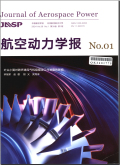Isothermal study of effusion cooling flows using a large eddy simulation approach
An isothermal numerical study of effusion cooling flow is conducted using a large eddy simulation (LES) approach. Two main types of cooling are considered, namely tangential film cooling and oblique patch effusion cooling. To represent tangential film cooling, a simplified model of a plane turbulent wall jet along a flat plate in quiescent surrounding fluid is considered. In contrast to a classic turbulent boundary layer flow, the plane turbulent wall jet possesses an outer free shear flow region, an inner near wall region and an interaction region, characterised by substantial levels of turbulent shear stress transport. These shear stress characteristics hold significant implications for RANS modelling, implications that also apply to more complex tangential film cooling flows with non-zero free stream velocities. The LES technique used in the current study provides a satisfactory overall prediction of the plane turbulent wall jet flow, including the initial transition region, and the characteristic separation of the zero turbulent shear stress and zero shear strain locations.Oblique effusion patch cooling is modelled using a staggered array of 12 rows of effusion holes, drilled at 30° to the flat plate surface. The effusion holes connect two channels separated by the flat plate. Specifically, these comprise of a channel representing the combustion chamber flow and a cooling air supply channel. A difference in pressure between the two channels forces air from the cooling supply side, through the effusion holes, and into the combustion chamber side. Air from successive effusion rows coalesces to form an aerodynamic film between the combustion chamber main flow and the flat plate. In practical applications, this film is used to separate the hot combustion gases from the combustion chamber liner. The numerical model is shown to be capable of accurately predicting the injection, penetration, downstream decay, and coalescence of the effusion jets. In addition, the numerical model captures entrainment of the combustion chamber mainstream flow towards the wall by the presence of the effusion jets. Two contra-rotating vortices, with axes of rotation along the stream-wise direction, are predicted as a result of this entrainment. The presence and characteristics of these vortices are in good agreement with previous published research.
effusion cooling、large eddy simulation、isothermal analysis、film cooling、turbulent wall jet
24
V231.1(航空发动机(推进系统))
2009-05-22(万方平台首次上网日期,不代表论文的发表时间)
共11页
729-739




